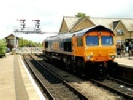Archive Section




A Lecture by David Coxon, retired Bogie Warranty Engineer, Bombardier
Tuesday 5th March 2019, 55 Broadway
Written by John Doyle
David Coxon is a railwayman of many years who began his career with British Rail and recently retired from Bombardier in Derby as one of their bogie warranty engineers.
David gave an intriguing illustrated talk about his part in some very unusual movements of British rolling stock on the European rail network. In an era when we have seen class 20, class 37, class 56, class 66 and classes 86 and 87 locomotives finding second careers on mainland Europe this may not seem so unusual, but at the time it certainly was.
David began his account of “exploits abroad with trains” by describing how in the late 1980’s before the construction of the Channel tunnel he was asked to organise the movement of rolling stock by sea and rail to an exhibition staged in Hamburg. The exhibition IVA 88 was a trade event which was a precursor to the now regular Innotrans exhibitions.
The rolling stock selected to represent the, then, cutting edge of the UK Rail industry was locos 89001, 90008 and 91003, Sprinter DMU 150263 and BREL International coaches 99520 and 99523.
One of the complications of the move was that the class 150 had electrically controlled brakes using the Westcode braking system. Fortunately, the unit was equipped with end gangways so it was decided to marshal it between two match wagons with a brake pie run through the DMU. Before the consist of vehicles could set off for the continent a series tests was conducted at Old Dalby to establish the brake force and a safe maximum speed. The outcome of which determined the formation could operate at a maximum of 60 mph.
Transporting rolling stock abroad pre-
The train was hauled by locomotives of the various national operators of the countries through which it passed, SNCF, SNCB and finally DB. The route taken was via Tourcoing, Brussels, Aachan, Dusseldorf and the Ruhr. The exhibition was in May and June 1988. The British rolling stock was of considerable interest to visitors to the exhibition.
At the end of the exhibition David had to make the move all over again in the opposite direction.
The whole operation was judged to have been a success so when it was decided Britain’s railway should be represented at the 150th anniversary of Dutch Railways David was the man for the job. It had been intended to send a new class 158 DMU however a Super Sprinter 156502 in Strathclyde livery was selected for the trip. Certainly, unusually and possibly uniquely it was decided the unit should travel to the exhibition site in Utrecht under its own power.
Again, the route selected was via the Dover Dunkirk train ferry using the same ferry. The transit was not entirely smooth, bureaucracy intervened and at one point the unit was refused access to the Dutch network although attending the anniversary at the invitation of NS Dutch railways!
Again, the exhibit was popular with visitors. The same event was supported by other British rolling stock including two EM2 locos, but that would be another story.
The third and final trip was to take two Mark 4 vehicles to Vienna Arsenal for climatic testing during 1989. The facility on the site of a former military complex had the capacity to create climatic conditions ranging from -
David rounded off his talk by reprising the subsequent history of the train ferry “Nord Pas de Calais”. The advent of the Channel tunnel effectively killed off what remaining rail traffic there was. The ship was converted to solely accommodate road vehicles. And transferred to serve routes to and from Morocco. More recently the ship has been deployed on routes between the various Canary Islands.
To conclude David was able to answer several questions of detail from the audience who were engaged by the tales of unusual rail movements and thanked David in the usual way.
Our speaker maintains a very interesting website which charts his career, covers the trips he spoke about and much more, including photos of the transporting of the train to Europe, see : www.traintesting.com